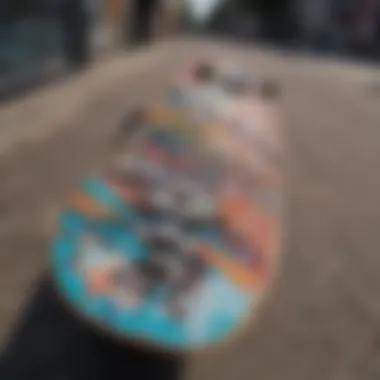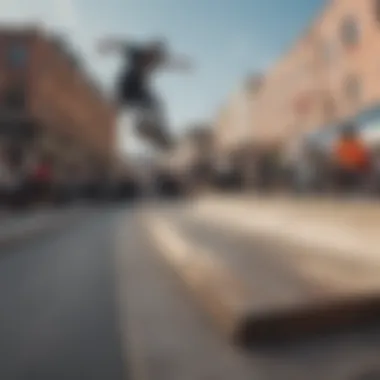Skateboard Culture Meets Streetwear: A Deep Dive


Intro
The realms of skateboarding and streetwear collide in a fascinating blend of culture and creativity. Each domain taps into vibrant pools of self-expression, and their intersection offers a tapestry woven with threads of style, identity, and history. By understanding the foundation of skateboard culture, we can better appreciate how it influences streetwear and urban lifestyle. This article takes you on a journey through this intricate connection while shedding light on the core elements that define both scenes.
Skateboarding Techniques
Skateboarding is not just a pastime; it’s a skills-driven art form that thrives on innovation. Whether you're a novice eager to catch your first ollie or a seasoned skater looking to master complex tricks, understanding the techniques is integral.
Essential Tricks for Beginners
Starting out can feel like standing at the edge of a ramp, uncertain yet excited. Here are some foundational tricks that every beginner should tackle:
- Ollie: The cornerstone of trick progression, where the skater leaps off the tail while sliding the back foot.
- Kickflip: A slight spin of the board while getting air. It's a right of passage for many skaters.
- Heelflip: Similar to the kickflip, but the foot movement is different. Instead of kicking with the toes, the heel flicks off the edge.
- Manual: Balancing on two wheels while rolling, it’s a must-have for showcasing control.
Advanced Maneuvers for Seasoned Skaters
Just when a skater thinks they've mastered the board, the game evolves. For experienced skaters, engaging with more complex tricks is crucial:
- 360 Flip: Combining a kickflip and a pop shuvit. It’s a true showstopper in the skate park.
- Board Slide: Sliding along a rail while maintaining balance and style. Precision is key.
- Smith Grind: Riding on a rail with one truck locked while the other hangs over the side.
Each trick embodies not only skill but also personal style, further strengthening the bond with streetwear aesthetics.
Skate Culture
Skate culture is a living narrative, continuously shaped by societal changes, community interactions, and distinctive styles that have evolved over decades. Its roots run deep in rebellion and creativity, reflecting the urban landscapes from which it originates.
The Evolution of Skateboarding Styles
Originally a tool for surfers to ride on land, skateboarding has transitioned through various styles:
- Freestyle: Focusing on tricks performed on flat ground, with an emphasis on technical prowess.
- Vert: Characterized by ramp systems that allow skaters to perform tricks in mid-air.
- Street: Emphasizes urban environments, utilizing staircases, benches, and rails as obstacles.
Every style reflects not just skill but also a specific cultural attitude, contributing to the evolving narrative of skateboarding.
Community Engagement and Local Events
The beauty of skate culture is its community-driven nature. Skate parks and local events serve as gathering spots, fostering camaraderie:
- Local Competitions: These events showcase rising talent while uniting skaters.
- Charity Skate Days: Such engagements promote inclusion and give back to communities.
- Online Platforms: Communities on Reddit and Facebook facilitate discussions, sharing tricks, or even organizing meet-ups.
"The essence of skate culture lies not merely in the tricks but in the relationships formed through shared passions and experiences."
Historical Context of Skateboard Culture
Understanding the historical context of skateboard culture is crucial as it lays the groundwork for how this subculture intertwined with streetwear. At its core, skateboarding emerged as more than just a sport; it became a lifestyle, a form of creative expression, and a medium that directly influenced fashion trends over the decades. The evolution of skateboard culture has shaped attitudes, identities, and even the urban landscape itself. By exploring this context, we can appreciate the social dynamics and transformative power of skate culture, especially in how it relates to street fashion today.
Origins of Skateboarding
Skateboarding can trace its roots back to the early 1950s in California. It started as a pastime for surfers who wanted to mimic their rides on land when the waves were flat. People fashioned makeshift boards using wooden planks and roller skate wheels, setting off a cultural phenomenon. Storefronts sold these early models often termed "sidewalk surfboards," yet little did they know that it would burgeon into a global movement. As enthusiasts of all ages began riding, a lifestyle took shape, and skateboarding became a canvas for creativity—allowing individuals to express themselves in ways never seen before.
"The skateboard is a tool for self-expression, a break from boundaries, and a way to embrace the art of motion."
Evolution of Skateboard Design
As the practice grew, so did the innovation surrounding skateboard design. The original boards were quite simple, resembling planks with little thought to performance. However, the shift in design began in the late 1960s and early 1970s when manufacturers like Z-flex and Dogtown introduced wider boards with shorter distances between wheels, enhancing stability and versatility. The rising popularity of tricks and stunts led to the creation of concave decks, offering skaters better control.
Key developments include the introduction of the urethane wheels in the late 1970s, which provided smoother rides and greater grip on a variety of surfaces. This advancement opened the door to a new era where skaters could push the limits of their skills, leading to innovations in both skateboards and tricks alike. Skateboarding moved from the streets to pools, then parks and later, specifically designed skate parks. The ever-changing skateboard design can now be seen as a reflection of the culture, responding to the needs of the riders and setting trends in streetwear that followed suit.
Key Influences from the Surf Culture
Skateboarding's synergy with surf culture is undeniable. The ethos of skate culture, much like surfing, revolves around freedom, self-discovery, and connection with the environment. Iconic surfers like Tony Alva and Jay Adams blurred the lines between the two cultures, infusing skateboard styles with surf aesthetics.
Surf brands such as Vans and Quiksilver began to tap into the skateboard market, understanding that their core customers were part of a vibrant subculture that valued authenticity and individuality. The vibrant illustrations and relaxed styles found in surfwear seamlessly integrated into skateboard fashion, resulting in an emerging trend where both communities influenced each other's values and designs.
In essence, the historical context reveals a rich tapestry woven from the threads of creativity, innovation, and a fervent desire to break from convention. Understanding this history helps modern enthusiasts and marketers navigate the current landscape of skateboard culture and streetwear, where both remain intricately linked.
The Birth of Streetwear
Streetwear has blossomed into a cultural phenomenon, intertwining seamlessly with the skateboarding ethos to create a distinctive urban aesthetic. This term encompasses more than just fashion; it's an expression of identity, a reflection of social movements, and a vessel for artistic commentary. Understanding the birth of streetwear is essential because it forms the backbone of styles associated with skate culture, showcasing the transition from niche counterculture to mainstream acceptance. This section dives into its origins and the pivotal elements that helped shape it.
Influence of Hip-Hop on Streetwear
Hip-hop culture served as a catalyst for streetwear’s rise in the late 20th century. Emerging from New York City's Bronx neighborhoods in the late 1970s, hip-hop introduced a new attitude that valued self-expression and creativity. As graffiti artists and rappers dominated the scene, the clothes became a canvas for their stories and identities.
Hip-hop stars like Run-D.M.C. and LL Cool J were crucial in popularizing streetwear. They didn't just perform; they wore their lifestyle. Run-D.M.C.'s collaboration with Adidas in the 1980s ushered in a new movement where clothing wasn’t just clothing – it was a statement. The iconic three-stripe track suits became synonymous with hip-hop, establishing a precedent for partnerships between fashion and music that still resonates today. This convergence brought urban fashion to mainstream consciousness, paving the way for styles blending skate and street culture.
Streetwear's Connection to Graffiti Art
Graffiti art intersects deeply with streetwear, both emerging from the same urban environment and sharing a rebellious spirit. Graffiti is more than just vandalism; it carries a voice of protest and individuality often seen in streetwear designs. Artists like Keith Haring and Jean-Michel Basquiat influenced clothing brands with their striking visuals that often appeared on t-shirts and hoodies.


Brands, such as Obey Clothing, derive their aesthetics directly from this vibrant art movement. The use of bold colors, radical graphics, and political messages in both graffiti and streetwear communicates a sense of urgency and relevance in contemporary culture. The message is clear: art from the streets is not only a pastime but also fuels a lifestyle that transcends traditional boundaries of fashion.
"Streetwear is not just clothes; it’s an attitude, an unwritten code. It's influenced by the beats of hip-hop and the strokes of graffiti artists who claim their space in a world that often overlooks them."
Fashion Icons Shaping Street Style
The evolution of streetwear owes much to various fashion icons who’ve shaped its trajectory. Figures like Pharrell Williams and Kanye West are not just music producers; they’re trendsetters whose influence has blurred the lines between street fashion and high-end couture. Pharrell's collaborations with brands like Billionaire Boys Club and Adidas have established an empire that celebrates street aesthetics whilst exuding luxury.
Similarly, Kanye's Yeezy line has taken the fashion world by storm, merging streetwear with the realm of high fashion. His visionary approach to design has pushed the boundaries by incorporating unique silhouettes and unconventional materials.
In addition, there are countless figures from the skateboarding community, like Tony Hawk and Nyjah Huston, whose personal styles have inspired countless fans and budding designers alike. Skate icons have routinely collaborated with streetwear brands, ensuring the skate culture remains at the forefront of urban fashion trends.
Streetwear, influenced by such icons, reflects the dynamic blend of culture, politics, and lifestyle that acknowledges diversity and drives creativity, particularly within the skateboard community. The evolution of this realm continues as fashion icons emerge, influencing the very fabric of what it means to wear streetwear today.
Significant Brands in Skateboard Streetwear
When we talk about the intersection of skateboard culture and streetwear, the discussion wouldn’t be complete without highlighting Significant Brands in Skateboard Streetwear. These brands don’t just sell apparel; they encapsulate a lifestyle, creating a bridge between those who skate and urban fashion enthusiasts. By integrating elements of skate culture into their designs, these brands shape public perceptions and establish their own unique identity within the broader landscape of streetwear.
The Influence of Stussy
Stussy stands as a monumental name in the streetwear arena, solidly tied to skateboarding since the early days. Founded by Shawn Stussy in the 1980s, what started as a surfboard company quickly expanded into a lifestyle brand that encapsulated the spirit of rebellion synonymous with skateboarding.
The signature Stussy logo, distinct and memorable, reflects not just an aesthetic but a cultural statement. It resonates deeply with both skaters and urban dwellers, fostering a sense of belonging to a community that values creativity over conformity. The clothing line includes oversized tees, baggy shorts, and iconic caps that became staples in skater wardrobes.
Stussy’s collaborations with artists and other brands demonstrate its ongoing relevance and adaptability. This strong influence has helped legitimize streetwear's place alongside high fashion, making it clear that skate culture has major sway in contemporary society. The brand doesn’t merely follow trends; it sets them, proving that skateboarding and streetwear are both inextricably linked.
Element and the Eco-Conscious Movement
In recent years, a shift has begun to emerge with brands like Element carving their name in the skate-streetwear scene, emphasizing sustainability and eco-responsibility. Founded on the principles of protecting the environment, Element draws a correlation between skateboarding's natural settings and the need for thoughtful production practices.
Sustainability in skateboard streetwear is reflected in materials used, such as organic cotton, recycled fabrics, and other innovative resources that lessen environmental impact. Not just a marketing gimmick, these practices are at the heart of Element's philosophy, encouraging young skaters to understand their role in preserving the very landscapes they enjoy.
Some key initiatives include:
- Eco-friendly fabrics: Transitioning from traditional materials to more sustainable options.
- Community Engagement: Programs aimed at educating skaters about environmental issues.
- Sustainable Packaging: Utilizing recycled and biodegradable packaging materials.
By championing eco-consciousness, Element positions itself as a leader in responsible streetwear, steering both skateboard culture and fashion toward a more sustainable future, which resonates well with today's younger, values-driven consumers.
Supreme: Icon or Commodity?
Supreme, a name that sends ripples through both fashion and skateboard communities, stands at the center of much debate. The brand has grown into a cultural powerhouse, seen as both an icon of streetwear and a hotbed of controversy regarding its commercialization.
Founded in 1994, Supreme infused skate culture with an exclusivity that few have matched. The strategic scarcity of its products means that a simple t-shirt or pair of sneakers can become a coveted item, often fetching unbelievable prices on resale markets. This limited edition strategy exemplifies the balancing act between accessibility and exclusivity, making Supreme a double-edged sword in the world of streetwear.
Critics argue that Supreme’s approach dilutes the true essence of skateboarding by transforming genuine passion into a commodity. On the other side, fans laud the brand's ability to merge high art, music, and skate, creating a unique cultural zeitgeist. With numerous collaborations—like those with Louis Vuitton—Supreme continually challenges the boundaries of what streetwear can achieve.
"Supreme isn’t just clothing; it’s a token in the culture, trading comfort for status."
Ultimately, Supreme illustrates the complicated relationship between skating, commerce, and identity. It stimulates debate on whether streetwear should remain a community-driven movement or embrace its role within the global marketplace.
Fashion Trends in Skateboarding
Skateboarding isn't just about the tricks and grinding down rails; it's also about style. Fashion trends in skateboarding represent an aesthetic that's as integral to the sport as the board itself. These trends create a visual language that communicates a skater's identity, beliefs, and affiliations. At the intersection of skateboard culture and streetwear, fashion trends serve not just practical needs but also reflect broader cultural narratives. Skaters often wear functional clothing that allows for movement while also making a statement. Recognizing the latest trends in this sphere can open doors for enthusiasts and marketers alike.
Current Styles in Skateboarding Apparel
The styles in skateboarding apparel are a melange of practicality and urban flair. While the early days of skate fashion were dominated by loose-fitting jeans and logo-emblazoned tees, today’s skaters often sport baggy cargo pants paired with oversized graphic shirts. Brands such as Vans have cemented their place in the scene with their classic skate shoes, which have become synonymous with skater style.
Recent trends highlight the usage of fabrics that facilitate movement while still portraying a laid-back vibe. For instance, water-resistant materials are gaining popularity, thus allowing skaters to take on different environments without changing their clothes. In addition, color palettes often lean towards muted tones, yet bursts of neon are not far behind in skate parks to catch the eye vibrantly. Ultimately, apparel in skating functions as a cultural identifier, helping skaters connect over shared aesthetics while they ride.
Footwear's Strategic Role
Footwear in skateboarding plays a significant role that extends beyond merely providing grip. It is an emblem of personal expression and a pivotal part of skate culture. Shoes like the Nike SB Dunk have transcended their functional roots, becoming a must-have item in skateboarding and streetwear wardrobes alike.
The structure of skate shoes is designed specifically for the rigors of skating. High tops give ankle support, while the flat soles ensure better board feel and control. But it’s not all about function; the design itself often carries deep sentiments. Limited editions and collaborations—like the ones seen with Supreme—elevate a simple shoe into a piece of art. This convergence of artistry and utility creates footwear that is eagerly sought after, signifying status within the skate community.
Accessories that Define the Look
While apparel and shoes are central to skateboarding fashion, accessories play a pivotal role too. From snapbacks to beanies, the right accessory can make or break a skater's look. Skate culture is rich in individual expression, and accessories provide that extra personal touch.
- Hats: A go-to for many skaters, snapbacks and beanies secure a skater’s 'fit while shielding them from the sun or the cold.
- Backpacks: Functionality meets style here. Skaters need something practical to carry their boards, but they also lean towards brands that reflect their style, like Thrasher.
- Jewelry: Minimalist chains or bracelets can also be found on many skaters, often chosen for their symbolic meanings rather than showiness.
Accessories often reveal the individual's personality, ideally showcasing what's important to them. Whether it's a brand with social responsibility or a unique artwork on a bag, these items speak volumes about a skater's beliefs.
In essence, fashion trends within the skateboarding realm are complex yet fascinating, reflecting a culture rich in history and storytelling. The circumstantial defining elements—apparel, footwear, and accessories—together create a vivid tapestry of style that is not merely about aesthetics, but is interwoven with identity and community. Ensuring that these trends remain alive and evolving speaks to the heart of skateboard culture itself.
The Role of Social Media in Shaping Culture
In today's world, social media is more than just a platform for sharing photos or daily updates. It’s become the lifeblood of many subcultures, including skateboard culture and streetwear. The fast-paced environment of social media provides an unparalleled stage for promoting edgy fashion, radical skate tricks, and a shared sense of identity among enthusiasts. This section will explore how social media acts as a catalyst for cultural exchange, trends, and community building within these intertwined worlds.
Influencers and their Impact


Influencers play a critical role in the relationship between skateboarding and streetwear, acting as both ambassadors and trendsetters. Their online presence can sway public opinion, often driving the popularity of specific brands or styles. When an influencer posts a clip of their latest trick while wearing a certain brand, followers often take notice.
For example, consider figures like Nyjah Huston or Lizzie Armanto, who possess a significant social media following. The styles they endorse not only resonate with their fans but also create waves within the larger skate community. It’s not uncommon to see entire collections selling out within hours after being featured by a skateboarding influencer. Social media platforms like Instagram have paved the way for these personalities to showcase their skills while influencing streetwear trends, making fashion choices as prominent as their athleticism.
Hashtags and Trends Propagation
Hashtags serve as the breadcrumbs leading followers down a rabbit hole of trends. By strategically using hashtags, users can connect with fellow skaters and streetwear enthusiasts. Hashtags like #SkateFashion, #Streetwear or #SkaterStyle unite disparate voices and styles into broader conversations. These tags create a sense of belonging, making it easier for individuals to discover new brands and styles.
People often engage with trending topics, and viral movements can arise overnight. Styles that were once niche can explode into mainstream culture faster than ever.
Additionally, brands themselves often harness hashtag campaigns to create buzz around product launches or collaborations. They might promote a limited-run sneaker drop with a catchy hashtag, like #KicksofCulture, encouraging fans to share their own interpretations or favorite outfits. This not only fosters engagement but rapidly carves out a larger market presence.
Online Communities: Fostering Connections
Social media has developed platforms where skateboarders and streetwear lovers alike can gather virtually. Places like Reddit, Facebook groups, or even specific pages on Instagram serve as cultural hubs. Here, users share tricks, styles, and even local skate spots. The sense of community is palpable as individuals connect over mutual hobbies and experiences.
"Social media isn't just about how many followers you have, but about creating connections with like-minded folks. It’s the threads that bind us together…"
— An Influencer’s Take
These spaces allow for authentic dialogue and exchange, where individuals can express their ideas and learn from others. Another crucial benefit is niche communities, which can vary from urban styles specific to certain cities to boards featuring eco-conscious brands. Members share reviews, efficient tips, and personal stories, deepening connections within the culture.
Community and Identity in Skate Culture
Skate culture goes beyond just the act of riding a board; it is rooted in a strong sense of community and identity. For many skateboarders, the sport acts as a social glue, binding individuals who share a passion for skateboarding regardless of their background. This collective identity has spurred a unique culture characterized by values such as inclusivity, creativity, and rebellion against societal norms.
The importance of community in skate culture cannot be overstated. Unlike other sports, skateboarding cultivates personal expression and local identity. From the common bond developed while learning a new trick to the shared excitement during a well-deserved session at a local spot, these experiences foster camaraderie. The neighborhood becomes a canvas, with each skater leaving their mark, metaphorically and literally.
Shared Values and Ethics
At the heart of the skateboarding community lies a set of shared values and ethics. Most notably, the concept of respecting spaces and creating an inclusive atmosphere stands tall among skaters. This is particularly vital in urban settings, where many skateboarders face pushback from local authorities.
For instance, skaters often have a strong code about treating public spaces with respect, even as they bend the rules just a fraction. They voice this sense of ownership through spoken agreements and unwritten rules. The idea is simple: leave no litter, be considerate of others, and, if the vibe is right, engage in some positive skater solidarity. This ethos ultimately makes skate culture a more inviting space for new talent and enthusiastic enthusiasts.
Local Skateshops: Cultural Hubs
Local skateshops serve as vital cultural hubs within the skateboarding community. These shops are not just retail points but places where storytelling happens. Skaters gather to discuss tricks, skills, and life experiences, sharing a sense of belonging with their peers. Each skateshop likely has its own flavor, something that keeps the community vibrant.
"A skateshop isn’t just a place to buy a board; it’s where friendships spark and legends are born."
When entering a local shop, one might find a mural featuring local legends, or hear the clatter of decks as a group ritualizes tying their laces before a session. This not only deepens community ties but also fosters emerging talent, giving a platform for local skaters to be seen and heard.
Events and Competitions: Building Camaraderie
Events and competitions within the skate culture play a significant role in building camaraderie among skaters. Whether it’s a local contest or an impromptu gathering at a nearby park, these events break down barriers and encourage participation across all skill levels. The shared adrenaline of landing a trick during a competition or simply cheering on a friend feeds directly into the collective spirit.
Skate competitions often attract diverse crowds, bridging gaps between experienced veterans and newcomers. Those who participate often find themselves taking part in workshops, learn new tricks, and take home more than just trophies - authenticity and connectedness become a common thread. These gatherings help cement the idea that everyone has a role, reinforcing the understanding that skateboarding, while individualistic, thrives on community spirit.
Ultimately, the intersection of community and identity in skate culture symbolizes resilience and unity. Skaters, whether seasoned or fresh-faced, find solace and strength within this shared passion, bringing a unique cultural identity to the forefront.
The Globalization of Skateboard Streetwear
The phenomenon of globalization in skateboard streetwear is undeniably significant, having reshaped not just how culture is perceived, but also how it is expressed across the world. This globalization connects diverse communities, allowing for an exchange of ideas, styles, and practices that were once confined to local neighborhoods. As skateboard culture spread, so did the streetwear that accompanies it, making it accessible to a wider audience than ever before. The blend of regional styles with global influences has led to a dynamic evolution of fashion, where every piece tells its own story and connects skaters from all walks of life.
Emergence of International Brands
The rise of international brands in skateboard streetwear brought the local, small-scale operations into a much larger playing field. Brands like Palace Skateboards, Off-White, and Anti Social Social Club have gained a reputation that crosses borders. This transformation can be attributed to the accessibility of the internet and social media, which has allowed these brands to market directly to global audiences. Skaters and fashion enthusiasts can now order directly from these sites, blurring the lines between local street culture and global fashion.
With international brands comes the challenge of maintaining authenticity. While brands want to reach a wider audience, they also need to stay true to their roots. The balance between commercial success and cultural relevance is a tightrope that many brands walk. This shift also leads to a saturation of the market; with so many options available, how does one brand stand out?
Cultural Exchanges within the Skateboarding Community
The essence of skateboarding has always been about community. The globalization of skateboard streetwear has amplified these communities, allowing different cultures to intermix. For instance, skaters from Tokyo may adopt design elements from Los Angeles while adding their twist. Likewise, New York’s gritty street style may influence trends seen in Milan. These exchanges can happen through social media, skate events, or even collaborative projects between brands and artists.
There’s a beauty in how something like a skate deck design travels across oceans and adapts to various cultural contexts. This starts to create a tapestry of styles that make each piece unique yet inherently connected to global skate culture. Workshops, meet-ups, and online forums become vibrant platforms for sharing not just fashion preferences, but also skating techniques and philosophies.
"The best skate ticks, the coolest threads, and the strongest friendships are often forged at the intersections of cultures."
Fashion Escapades Across Continents
Traveling for skateboarding and streetwear has become a cultural expedition. As skaters journey to different countries, they also explore local streetwear scenes. This creates opportunities for unique fashion escapades, as skaters bring back unique pieces and ideas from their experiences. Remember the latest skate shoes that have become popular in Barcelona? They might not be available elsewhere, which creates a sense of exclusivity and desirability.
Fashion shows and exhibitions dedicated to skate culture have started popping up internationally, presenting a platform for designers to showcase their work. Events like these foster connections among global skaters and casual fans alike, building a community that transcends borders.
As skaters roam from continent to continent sporting their gear, they share their passion with the world, turning every street, park, or shop into a potential runway.
This intermingling of cultures not only brings diversity to streetwear but continues to fuel the passion that defines skate culture.
Influences of Skateboarding on Mainstream Fashion
Skateboarding has transcended its rebellious roots to become a significant player in the world of mainstream fashion. This transition is not merely about aesthetics; it reflects deeper cultural values and shifts within society. Recognizing how skating influences styles can reveal much about urban culture and its evolving trends.


A pivotal aspect of skateboarding's impact on fashion is its intermingling with other youth-driven movements. For instance, brands like Supreme and Off-White draw from street culture, cultivating a look that balances casualness with high-end appeal. Many skaters value authenticity, and brands tap into this by using skateboarding imagery and designs that resonate with their target audience.
Collaborations with High Fashion Brands
The crossover between skateboarding and high fashion has grown in recent years. For instance, the partnership between Nike SB and Off-White not only highlights the blend of functionality and style but also elevates skateboarding’s status in haute couture. Such collaborations push the narrative that skateboarding can be both edgy and chic.
Brands like Vans, with their classic slip-ons, have effectively secured a position within luxury fashion, seen gracing the feet of runway models.
Some noteworthy collaborations include:
- Adidas x Palace Skateboards
- Burberry and Palace’s capsule collection
- Retailers partnering with skater brands for limited editions
These alliances serve to broaden the appeal of skatewear, making it accessible to audiences who might not regularly step on a board yet yearn for that urban vibe.
"It’s not just about the skateboard anymore; it’s about a lifestyle encapsulated in a brand’s identity."
Turning Points in Fashion History
Several key moments stand out in the timeline of skateboarding's influence on fashion. One could argue that the 1980s was the watershed era when skateboarding entered the mainstream consciousness. The trickle-down effect began, with the emergence of iconic brands that encapsulated a lifestyle rather than just protective gear. Decks adorned with artistic designs and rebellious logos caught the eye beyond the skate parks.
Fast forward to the late '90s, where brands like Quiksilver and Element started showcasing their products in fashion magazines. This shift marked a significant turning point, where skate culture began to influence haute couture.
Further turning points include:
- The launch of Thrasher magazine, which spotlighted skate style on its covers.
- Street style influences making their way into collections during New York Fashion Week.
- The viral phenomenon of social media showcasing skating influencers pushing the fashion envelope.
Skate Culture's Reach Beyond the Skate Park
Skateboarding is not confined to skate parks; it spills over into lifestyle and identity. The aesthetic primarily speaks to freedom, expression, and an urban ethos found in graffiti art and hip-hop culture. As a result, we see how skate culture has been adopted and adapted by communities globally.
From music festivals to street art at urban events, skate culture manifests in ways that attract diverse audiences. Here’s how:
- Fashion Shows: Designs inspired by skating often feature in major fashion events.
- Pop-up Shops: Limited edition releases by skate brands attract not only enthusiasts but curious passersby.
- Art Collaborations: Projects that merge skateboarding with visual arts, creating murals or street installations enrich local urban landscapes.
Through the lens of fashion, skateboarding symbolizes a broader cultural narrative. Dissecting this influences can shine a light on future trends and evolving expressions within the urban fashion landscape.
Challenges and Controversies within Skateboard Streetwear
Skateboard streetwear is at a unique crossroads, intertwining deep-rooted culture with contemporary issues. Engaging in this area is not just about aesthetics; it’s about navigating a landscape filled with possible pitfalls. Understanding the challenges and controversies that arise helps in recognizing the potential repercussions on the community and its values. The following subsections address significant concerns that highlight the delicate balance between preserving authenticity and appealing to a wider audience.
Commercialization vs. Authenticity
The surfacing of major labels alongside grassroots brands has ignited a heated debate over commercialization in skateboarding. As skate culture received attention from mainstream brands, it led to lucrative collaborations, and while they can elevate the scene, they also raise questions of authenticity.
Skaters often rely on a genuine expression of identity that links back to their origins. When brands deviate from grassroots principles for profit, the feeling of betrayal creeps in. Brands like Supreme, while celebrated, sometimes face backlash for pricing and availability which many perceive as exclusionary. The challenge lies in ensuring that while companies expand, they do not lose sight of their roots or neglect the very community that helped them flourish.
"Authenticity binds the skate culture; without it, we just become a fashion statement, losing what we stood for."
Gentrification of Skate Spots
As urban areas transform, skate spots once cherished for their raw accessibility can become victims of gentrification. This term often encompasses unwanted changes, such as rising rents and demographic shifts, pushing original skaters out of neighborhoods they’ve called home.
Cities increasingly cater to tourists and external investors, sometimes demolishing or repurposing iconic spots into sanitized, brand-centric playgrounds. While new parks may seem welcoming, they might lack the spirit that characterized grassroots skate spots. This transformation can alienate local skaters and ruin the tight-knit communities that developed around these areas. The fight to preserve beloved spaces is ongoing, as it encapsulates the essence of skateboarding—freedom, community, and cultural expression.
Cultural Appropriation Concerns
Cultural appropriation finds its way into the very fabric of skateboard streetwear, often leading to heated discussions surrounding originality and respect for heritage. As streetwear borrows from diverse cultures, it must tread lightly to honor rather than exploit those communities.
For instance, designs or styling that draws heavily from Indigenous or marginalized cultures without understanding their significance can lead to accusations of appropriation. Skaters and brands must be mindful of whose stories they are telling and how they engage with diverse influences for inspiration. Critics often call for brands to engage authentically, promoting inclusivity while avoiding merely capitalizing on cultural aesthetics.
As this narrative unfolds, it illustrates the complex interplay between creativity and respect—a test of the integrity within the skateboard culture entwined with fashion.
The Future of Skateboard Streetwear
As we look toward the horizon of skateboard streetwear, it becomes clear that the landscape is shifting. The fluid relationship between skate culture and street fashion is not only evolving but thriving in new directions. Examining this future requires an understanding of various elements, like sustainable methods, innovations in gear, and emerging trends in style. Each aspect contributes significantly to the upcoming era of skateboard streetwear, making it not just a cultural phenomenon but a crucial part of combating environmental and social challenges.
Sustainable Practices and Innovations
The emphasis on sustainability is moving from the sidelines to the forefront in skateboard streetwear. From compostable materials to recycled fabrics, brands are starting to answer the call for eco-conscious choices. The importance here lies not just in meeting consumer demand but also in promoting a healthier planet.
Many companies, such as Patagonia, are championing these sustainable efforts, showcasing the use of recycled polyester and organic cotton in their products.
Some skateboard brands collaborate with environmental organizations, creating limited-edition lines that donate profits directly to conservation efforts. This enriches their story, giving their merchandise added value beyond just fashion.
So, what are some ways that skateboard streetwear is making strides in sustainable practices?
- Recycled materials: Utilizing plastic waste to create trendy gear.
- Eco-friendly dyes: Using natural colors instead of harsh chemicals.
- Ethical labor practices: Ensuring fair wages for workers involved in the production process.
Implementing these strategies marks the emergence of an era where consumers, especially the younger crowd, are keenly aware of the environmental impact of their choices.
Technological Advancements in Skate Gear
Skateboarding is not just a form of self-expression; it also relies heavily on technology to enhance performance. Innovations in skate gear continue to reshape how enthusiasts engage with streetwear. Features integrated into skateboards and protective gear are lightyears ahead of what was available decades ago.
For instance, the advent of smart skateboards equipped with sensors to analyze tricks and provide feedback to riders is changing things. As skateboarding becomes more data-driven, it influences the design and style of apparel that accompanies the activity. Imagine a brand offering clothing embedded with technology to monitor body heat or movement, enhancing comfort and performance!
This tech-savvy approach to gear helps to redefine what it means to be a skater today. Brands are now leveraging partnerships with tech firms to integrate advancements like anti-shock fabrics or built-in air cushions to provide better support during trick landings.
Some popular trends are:
- Wearable tech: Devices that assist in tracking performance or injuries.
- Enhanced durability: Materials designed to withstand severe wear and tear.
- Customizable gear: Allowing skaters to modify looks or features on their boards.
These advancements not only elevate the skating experience but also have a corresponding effect on streetwear; the lines between high-performance and style are increasingly blurred.
Predicted Trends in Street Fashion
The future trends in street fashion reveal a unique blend of innovation and tradition. We can expect to see a variety of influences shaping the aesthetics of skateboard culture. The growing presence of diverse streetwear styles across the globe is inspiring skaters to adopt fresh approaches. Something to note is the way fashion cycles back; much of what’s old is new again.
- Retro-inspired designs: Patterns and colors reminiscent of the 80s and 90s are making waves. Think neon lights meeting oversized fits.
- Gender-neutral clothing: Breaking away from traditional norms, many brands are opting for unisex lines, making skate fashion more inclusive.
- Collaborations: Expect more partnerships between established streetwear brands and artists or cultural icons.
- Local flavors: Skateboard streetwear will increasingly reflect local cultures, tapping into the essence of different urban landscapes.
Ultimately, the future of skateboard streetwear is entwined with numerous evolving elements.
"Fashion is an unusual symbiosis; how clashing styles can be cohesively stitched together can redefine what's considered cool." This notion encompasses myriad outlooks, and integrating these perspectives into streetwear will evoke changes that continue to captivate enthusiasts and casual observers alike. In embracing these forthcoming shifts, skateboard culture and streetwear ensure they remain relevant in a rapidly changing world.















